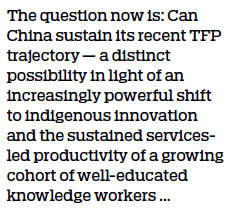No middle-income trap for China
There has always been a fixation on Chinese economic growth - and with good reason. China sustained an average annual growth rate of 10 percent from 1980 to 2011, unprecedented for a large economy. Since 2012, however, the annual growth has slowed down with the Government Work Report presented recently by Premier Li Keqiang setting a growth target of 6-6.5 percent for 2019.
For China doubters, this is a "gotcha" moment. After all, the premier's growth target implies a 40 percent deceleration from the "miracle" trend. This seems to vindicate warnings of the dreaded "middle-income trap" - the tendency of fast-growing developing economies to revert to a much weaker growth trajectory just when they get their first whiff of prosperity.

The early work on this phenomenon was precise in terms of what to expect: as per capita income moved into the $16,000-$17,000 range (in dollars at purchasing power parity in 2005), a sustained growth deceleration of around 2.5 percentage points can be expected. With China having hit that income threshold in 2017, according to International Monetary Fund estimates, its post-2011 slowdown looks all the more ominous.















